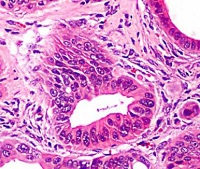 |
|
Invasive stage lesion in human PDAC-iPS line grown in immune-tolerant mice for 9 months--Courtesy of Kenneth Zaret
|
In what could be a significant advance toward better treatments for pancreatic cancer--a deadly type of cancer with an overall 5-year survival rate of about 6%--scientists have developed what they say is the first-of-its-kind human-cell model of the disease.
Currently, researchers and clinicians don't have a noninvasive way to detect early cells that indicate future disease, and that's a major reason why pancreatic cancer typically is detected so late in its course.
Using stem cell technology, researchers at the University of Pennsylvania's Perelman School of Medicine have created a research cell line from a patient with advanced pancreatic ductal adenocarcinoma (PDAC), or pancreatic cancer. The researchers say it's the first human-cell model to show the early progression of the disease. The research was published June 20 in Cell Reports.
Kenneth Zaret, a professor and associate director of the Penn Institute for Regenerative Medicine, and his team hypothesized that if they reprogrammed PDAC cells into pluripotent cells and then allowed them to redifferentiate into pancreatic tissue, they might undergo the early stages of cancer. To test this, they created the PDAC pluripotent cells and observed the early intermediate stages of pancreatic cancer in the cells. After isolating the cells at the early stage and culturing them in vitro, they identified the proteins released in the process that could act as possible early-stage biomarkers of disease progression.
The new approach allows researchers to study human pancreatic cancer cells directly, rather than examining disease progression in an animal model and then trying to translate that research to humans. But the Penn team's study does have limitations. Since the researchers only used a cancer cell line from one patient to reprogram the cells, the findings represent one individual's cancer. Still, this method has been used as a model to treat other types of diseases.
- here's the journal abstract
- read the press release